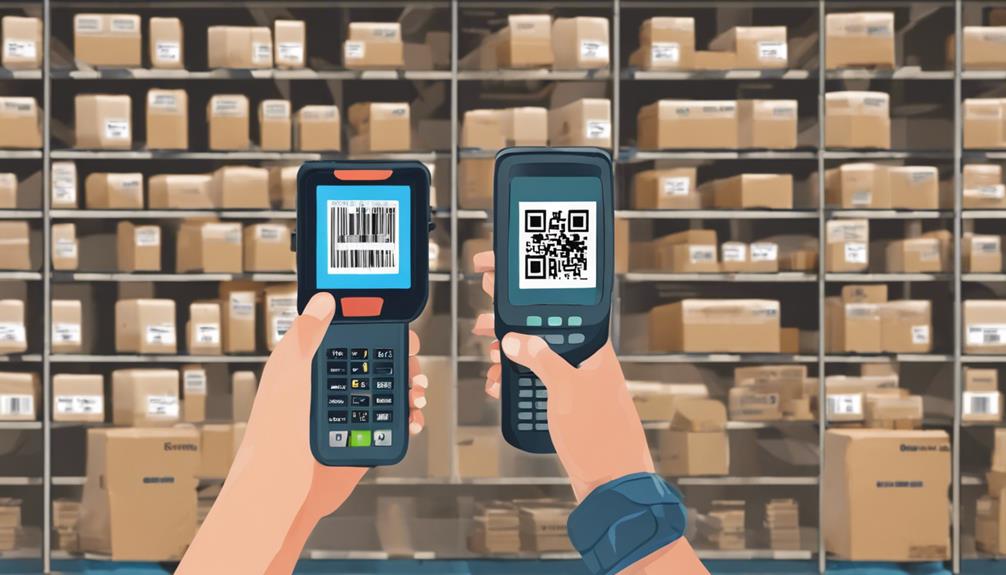You’ve likely encountered barcodes daily, but did you know the seven essential features of barcode indexing can revolutionize how businesses manage data? Understanding these features is key to unlocking efficiency and accuracy in your operations. From unique identification through sequential barcode assignment to seamless data exchange via integration benefits, each feature plays a vital role in optimizing workflows and ensuring reliable inventory management. Discover how these features can transform your processes and elevate your organization’s productivity and precision.
Understanding Barcode Types
When it comes to understanding barcode types, it is imperative to grasp the fundamental distinctions that exist between various formats. Barcode symbologies play a crucial role in determining how data is encoded and represented in a barcode. Different symbologies, such as UPC, Code 128, and QR codes, have specific characteristics that make them suitable for different applications.
Barcode scanning is the process of using a barcode reader or scanner to capture and interpret the information encoded in a barcode. The type of barcode symbology used will determine the scanning technology required. For example, linear barcodes are scanned using laser scanners, while 2D barcodes like QR codes are typically scanned using image-based scanners.
Understanding the nuances of barcode symbologies and scanning technologies is essential for ensuring accurate and efficient data capture in various industries such as retail, healthcare, and logistics. By selecting the appropriate symbology and scanning method for your specific needs, you can enhance your operational processes and improve overall productivity.
Steps in Barcode Indexing
Now let’s address the essential steps involved in Barcode Indexing. Begin with Sequential Barcode Assignment to establish a systematic order for identification. Utilize Data Capture Methods to accurately record and store information, while implementing Error Handling Strategies to mitigate any inaccuracies in the indexing process.
Sequential Barcode Assignment
How are barcodes assigned sequentially in the process of barcode indexing? The sequential barcode assignment process involves allocating unique identifiers in a numerical order to items or assets for efficient tracking and management. This method ensures that each barcode is distinct and follows a logical sequence, making it easier to organize and locate items within a database. By systematically assigning barcodes in a sequential manner, organizations can streamline inventory processes, minimize errors, and enhance overall productivity.
The barcode tracking benefits of sequential assignment include facilitating quick identification of items, enabling accurate inventory counts, and improving data accuracy. When barcodes are assigned sequentially, it simplifies the retrieval of information about products, reduces the chances of duplications or errors in data entry, and enhances the overall operational efficiency of the system. This structured approach to barcode assignment is particularly valuable in industries where precise inventory management is crucial for effective operations. By implementing sequential barcode assignment, organizations can optimize their tracking capabilities and improve inventory control processes.
Data Capture Methods
Utilizing efficient data capture methods is integral to the process of barcode indexing. Barcode scanning plays a crucial role in swiftly capturing data for indexing purposes. This method involves using specialized devices to read and decode the information stored in barcodes, enabling quick and accurate data retrieval. By scanning barcodes, you can efficiently input data into the indexing system, reducing errors and increasing productivity.
Data organization is another key aspect of effective barcode indexing. Once the data is captured through barcode scanning, it is essential to organize it systematically within the indexing system. Proper data organization ensures that information is easily accessible and retrievable when needed. By categorizing data based on relevant criteria such as product type, date, or location, you can enhance the efficiency of the indexing process and streamline data retrieval.
Error Handling Strategies
To effectively manage errors in barcode indexing, implementing robust error handling strategies is crucial. Error prevention is key to minimizing mistakes during data capture. Utilizing techniques such as double-checking entries and implementing validation rules can significantly reduce errors at the source. In the event that errors do occur, having efficient recovery techniques in place is essential. This includes having backup systems to restore data and protocols for correcting inaccuracies promptly.
Quality control plays a vital role in error handling strategies. Regularly monitoring the accuracy of barcode indexing processes through quality checks and audits helps identify and rectify errors before they escalate. Auditing methods such as comparing scanned data with physical records can help ensure data integrity and minimize discrepancies.
Best Practices for Barcode Indexing
Implementing best practices for barcode indexing is crucial for ensuring accurate and efficient data management. Workflow optimization plays a key role in enhancing the overall efficiency of barcode indexing processes. By analyzing and streamlining the sequence of tasks involved in barcode indexing, you can minimize bottlenecks and ensure a smooth and timely workflow. This optimization can lead to improved productivity and faster turnaround times in handling large volumes of data.
Quality control is another vital aspect of barcode indexing best practices. Establishing rigorous quality control measures helps in identifying and rectifying errors early in the indexing process. Regular audits, validation checks, and data verification procedures are essential for maintaining data accuracy and integrity. By ensuring high standards of quality control, you can minimize errors, reduce rework, and enhance the reliability of indexed data.
Incorporating these best practices not only boosts operational efficiency but also contributes to the overall effectiveness of barcode indexing systems. By focusing on workflow optimization and quality control, you can elevate the performance and outcomes of your barcode indexing activities.
Tools for Barcode Indexing
When it comes to barcode indexing, the tools at your disposal are crucial. You need to consider the software for indexing, ensuring it meets your specific needs. Additionally, evaluating hardware requirements and integration capabilities with existing systems are key factors for successful barcode indexing implementation.
Software for Indexing
For efficient and accurate barcode indexing, utilizing specialized software tools is essential. These tools not only aid in software integration but also significantly improve efficiency. When selecting software for barcode indexing, consider the following key aspects:
- Automation Capabilities: Look for software that offers automation features to streamline the indexing process. Automation can help reduce manual errors, increase speed, and enhance overall accuracy in barcode indexing tasks.
- Customization Options: Opt for software that allows customization to align with your specific indexing requirements. Customizable software can adapt to different barcode formats, data fields, and indexing workflows, ensuring a tailored solution for your indexing needs.
- Reporting and Analytics: Choose software that provides comprehensive reporting and analytics functionalities. These features enable you to track indexing performance, identify bottlenecks, and make data-driven decisions to optimize the indexing process continually.
Hardware Requirements
Considering the hardware requirements for barcode indexing is crucial to ensure a seamless and efficient process. When selecting hardware for barcode indexing, conducting compatibility checks is essential. Ensure that the barcode scanners and printers are compatible with the software being used to prevent any technical glitches during the indexing process. Additionally, regular maintenance of hardware components is vital to guarantee optimal performance.
Maintenance tips include cleaning barcode scanners and printers regularly to prevent dust accumulation that can interfere with scanning and printing quality. It’s also important to check for any loose connections or damaged cords and replace them promptly to avoid interruptions in the indexing workflow.
Investing in high-quality hardware that is durable and reliable is key to ensuring a smooth barcode indexing operation. By following compatibility checks and maintenance tips, you can enhance the efficiency and accuracy of your barcode indexing system.
Integration With Systems
How can the integration of systems enhance the efficiency of barcode indexing processes? Integrating barcode indexing systems with existing software and databases is crucial for maximizing productivity and accuracy. Here’s how system compatibility and workflow optimization can be achieved:
- Seamless Data Exchange: Ensure that the barcode indexing system can seamlessly exchange data with other systems such as inventory management software or customer databases. This integration streamlines processes and reduces manual data entry errors.
- Automated Workflows: Implement automated workflows between systems to eliminate redundant tasks and streamline the indexing process. By automating routine tasks like data entry and updates, efficiency is increased, and human errors are minimized.
- Real-Time Updates: Enable real-time updates across systems to ensure that all information remains current and consistent. This feature allows for instant access to the most up-to-date data, improving decision-making and overall operational efficiency.
Barcode Indexing for Different Industries
Rarely do industries today operate without the use of barcode indexing systems. Barcode indexing finds extensive industry applications across sectors such as retail, healthcare, logistics, manufacturing, and more. The benefits of barcode indexing in these industries include improved inventory management, increased operational efficiency, enhanced traceability, and reduced human errors. However, challenges like barcode label damage, scanning errors, and system integration complexities can arise.
In the retail sector, barcode indexing enables quick and accurate product tracking, leading to better stock management and reduced instances of overstock or stockouts. Healthcare facilities leverage barcode indexing to enhance patient safety through medication verification and tracking medical equipment. In logistics, barcode indexing streamlines the supply chain by providing real-time visibility into shipments and reducing shipping errors.
Manufacturing industries benefit from barcode indexing by optimizing production processes, tracking work-in-progress items, and ensuring quality control. Despite these advantages, industries must address challenges such as barcode label deterioration and compatibility issues between different barcode systems.
Troubleshooting Common Barcode Indexing Issues
Moving from the seamless integration of barcode indexing systems in various industries, we now focus on troubleshooting common issues that can impede the efficiency of these systems. When encountering problems with barcode indexing, consider the following troubleshooting techniques:
- Check Barcode Quality: One common mistake is overlooking the quality of the barcode itself. Ensure that the barcode is clear, undamaged, and properly printed to avoid scanning errors.
- Verify Scanner Functionality: Sometimes, issues arise from scanner malfunctions. Check if the scanner is functioning correctly, has adequate power, and is properly connected to the system.
- Review Data Entry Procedures: Incorrect data entry is a prevalent issue affecting barcode indexing systems. Double-check the data entry process to ensure that the correct information is being associated with the scanned barcodes.
Keeping up With Barcode Indexing Advancements
To remain competitive in the ever-evolving landscape of technology and data management, staying abreast of barcode indexing advancements is imperative. Industry applications demand a constant evolution in barcode indexing to enhance efficiency and accuracy. Technological advancements play a pivotal role in shaping the future of barcode indexing, with innovations like 2D barcodes, RFID integration, and cloud-based solutions revolutionizing how data is captured and processed.
In industry applications such as retail, healthcare, and logistics, staying updated on barcode indexing advancements can streamline operations, reduce errors, and improve overall productivity. By embracing new technologies and methodologies, organizations can ensure they are at the forefront of efficiency and data management.
Keeping pace with barcode indexing advancements requires a proactive approach, including attending industry conferences, engaging with experts, and investing in training programs. By prioritizing continuous learning and adaptation, businesses can leverage the full potential of barcode indexing to drive success in an increasingly digital world.
Frequently Asked Questions
Can Barcodes Be Easily Integrated With Virtual Reality Technology?
Like merging puzzle pieces, integrating barcodes with virtual reality technology is seamless. Barcodes’ compatibility and virtual reality integration offer a dynamic duo, enhancing user experiences and data management across diverse platforms effortlessly.
Are There Any Regulations for Barcode Labeling in the Food Industry?
When it comes to food safety, labeling requirements are crucial in the food industry. Regulations ensure accurate product information, allergen alerts, and traceability. Adhering to these standards is essential for consumer protection and compliance with industry guidelines.
How Can Barcodes Improve Supply Chain Sustainability Practices?
Picture this: By improving visibility, barcodes streamline supply chains, reducing waste and enhancing sustainability practices. They provide real-time data, enabling better inventory management and efficient resource allocation. Embrace barcodes for a greener future.
What Are the Security Measures for Protecting Barcode Data?
To protect barcode data, ensure robust security measures. Implement data encryption to safeguard information transmission. Utilize access controls to restrict unauthorized entry. These vital steps fortify the integrity and confidentiality of your barcode data, enhancing overall security.
Can Barcodes Be Used for Tracking Wildlife Populations?
You can track wildlife populations effectively using barcodes. This method aids in wildlife conservation efforts by providing accurate data for population monitoring. Barcodes offer a precise and efficient way to gather essential information for conservation purposes.



